Essay: Positive Impact of Team Diversity on Organization Performance
VerifiedAdded on 2023/01/06
|6
|1419
|60
Essay
AI Summary
This essay investigates the positive impacts of team diversity on organizational performance. It begins by defining team diversity, encompassing various dimensions like cultural, functional, and demographic differences among team members. The essay highlights how diversity enhances organizational performance through improved learning, creativity, innovation, and the ability to attract and retain top talent. It emphasizes that diverse teams foster more effective decision-making, problem-solving, and broader market appeal, leading to long-term sustainability. The essay uses research and case studies to support its claims, concluding that organizations that embrace team diversity experience higher performance due to effective coordination and teamwork.
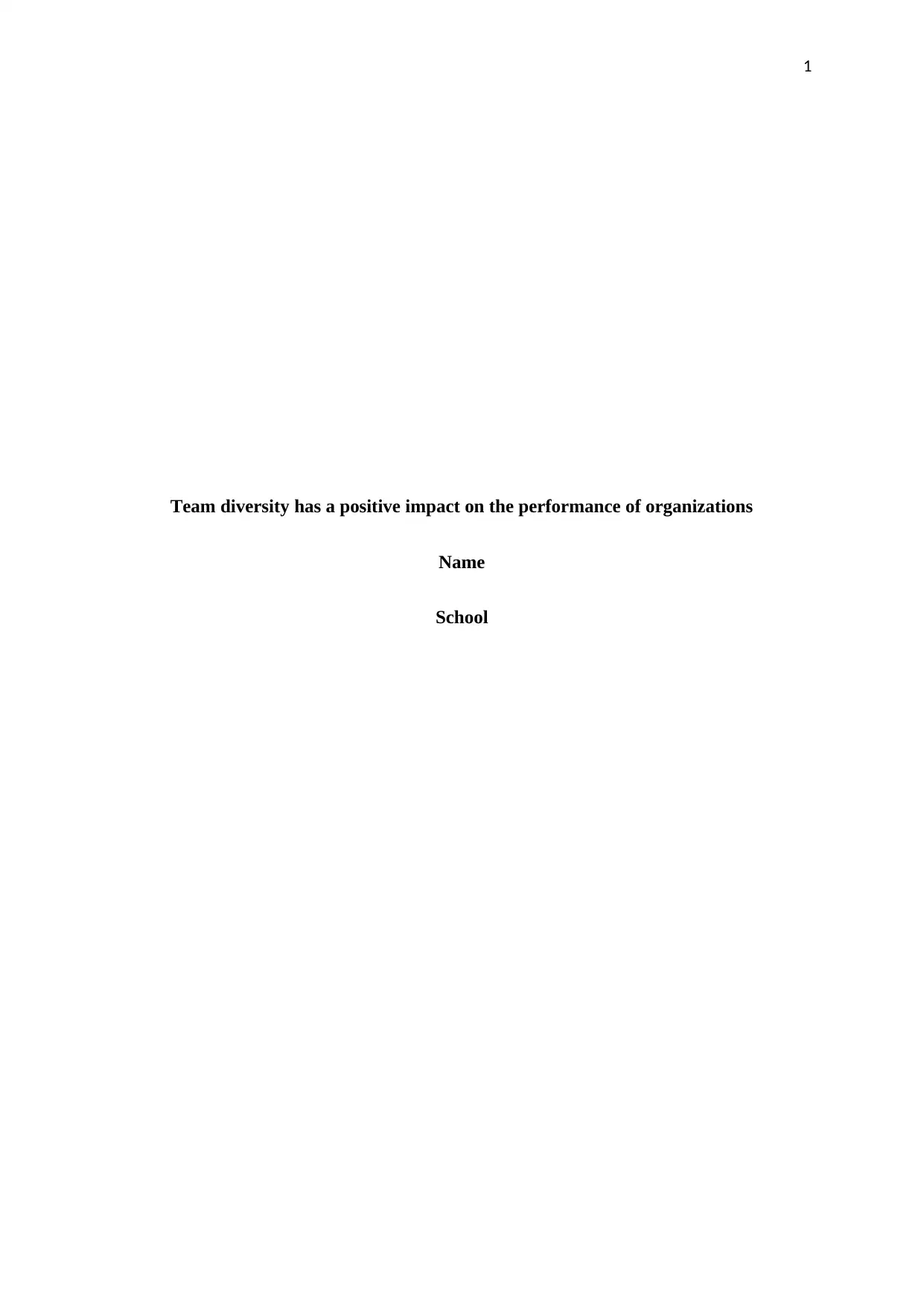
1
Team diversity has a positive impact on the performance of organizations
Name
School
Team diversity has a positive impact on the performance of organizations
Name
School
Paraphrase This Document
Need a fresh take? Get an instant paraphrase of this document with our AI Paraphraser
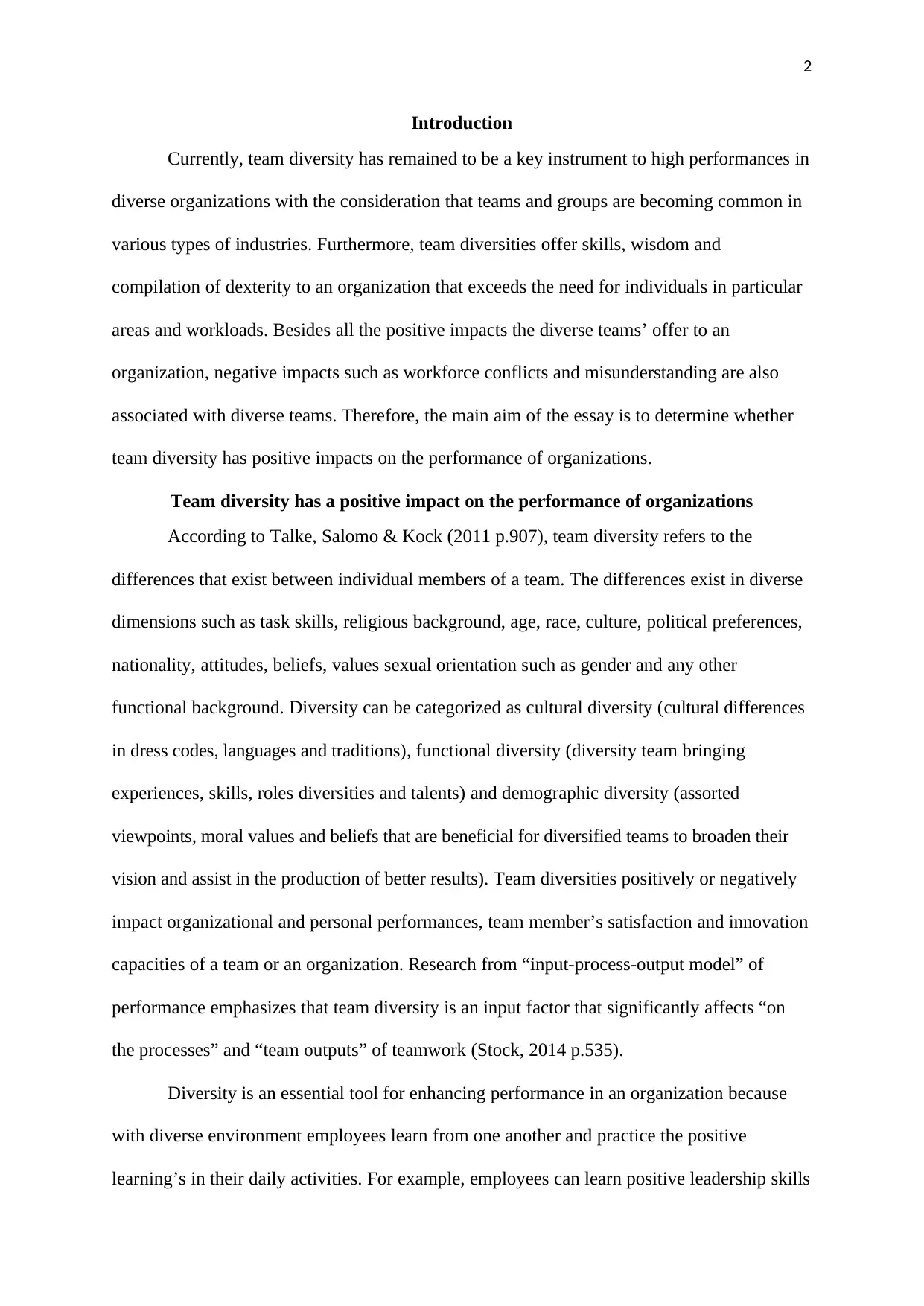
2
Introduction
Currently, team diversity has remained to be a key instrument to high performances in
diverse organizations with the consideration that teams and groups are becoming common in
various types of industries. Furthermore, team diversities offer skills, wisdom and
compilation of dexterity to an organization that exceeds the need for individuals in particular
areas and workloads. Besides all the positive impacts the diverse teams’ offer to an
organization, negative impacts such as workforce conflicts and misunderstanding are also
associated with diverse teams. Therefore, the main aim of the essay is to determine whether
team diversity has positive impacts on the performance of organizations.
Team diversity has a positive impact on the performance of organizations
According to Talke, Salomo & Kock (2011 p.907), team diversity refers to the
differences that exist between individual members of a team. The differences exist in diverse
dimensions such as task skills, religious background, age, race, culture, political preferences,
nationality, attitudes, beliefs, values sexual orientation such as gender and any other
functional background. Diversity can be categorized as cultural diversity (cultural differences
in dress codes, languages and traditions), functional diversity (diversity team bringing
experiences, skills, roles diversities and talents) and demographic diversity (assorted
viewpoints, moral values and beliefs that are beneficial for diversified teams to broaden their
vision and assist in the production of better results). Team diversities positively or negatively
impact organizational and personal performances, team member’s satisfaction and innovation
capacities of a team or an organization. Research from “input-process-output model” of
performance emphasizes that team diversity is an input factor that significantly affects “on
the processes” and “team outputs” of teamwork (Stock, 2014 p.535).
Diversity is an essential tool for enhancing performance in an organization because
with diverse environment employees learn from one another and practice the positive
learning’s in their daily activities. For example, employees can learn positive leadership skills
Introduction
Currently, team diversity has remained to be a key instrument to high performances in
diverse organizations with the consideration that teams and groups are becoming common in
various types of industries. Furthermore, team diversities offer skills, wisdom and
compilation of dexterity to an organization that exceeds the need for individuals in particular
areas and workloads. Besides all the positive impacts the diverse teams’ offer to an
organization, negative impacts such as workforce conflicts and misunderstanding are also
associated with diverse teams. Therefore, the main aim of the essay is to determine whether
team diversity has positive impacts on the performance of organizations.
Team diversity has a positive impact on the performance of organizations
According to Talke, Salomo & Kock (2011 p.907), team diversity refers to the
differences that exist between individual members of a team. The differences exist in diverse
dimensions such as task skills, religious background, age, race, culture, political preferences,
nationality, attitudes, beliefs, values sexual orientation such as gender and any other
functional background. Diversity can be categorized as cultural diversity (cultural differences
in dress codes, languages and traditions), functional diversity (diversity team bringing
experiences, skills, roles diversities and talents) and demographic diversity (assorted
viewpoints, moral values and beliefs that are beneficial for diversified teams to broaden their
vision and assist in the production of better results). Team diversities positively or negatively
impact organizational and personal performances, team member’s satisfaction and innovation
capacities of a team or an organization. Research from “input-process-output model” of
performance emphasizes that team diversity is an input factor that significantly affects “on
the processes” and “team outputs” of teamwork (Stock, 2014 p.535).
Diversity is an essential tool for enhancing performance in an organization because
with diverse environment employees learn from one another and practice the positive
learning’s in their daily activities. For example, employees can learn positive leadership skills
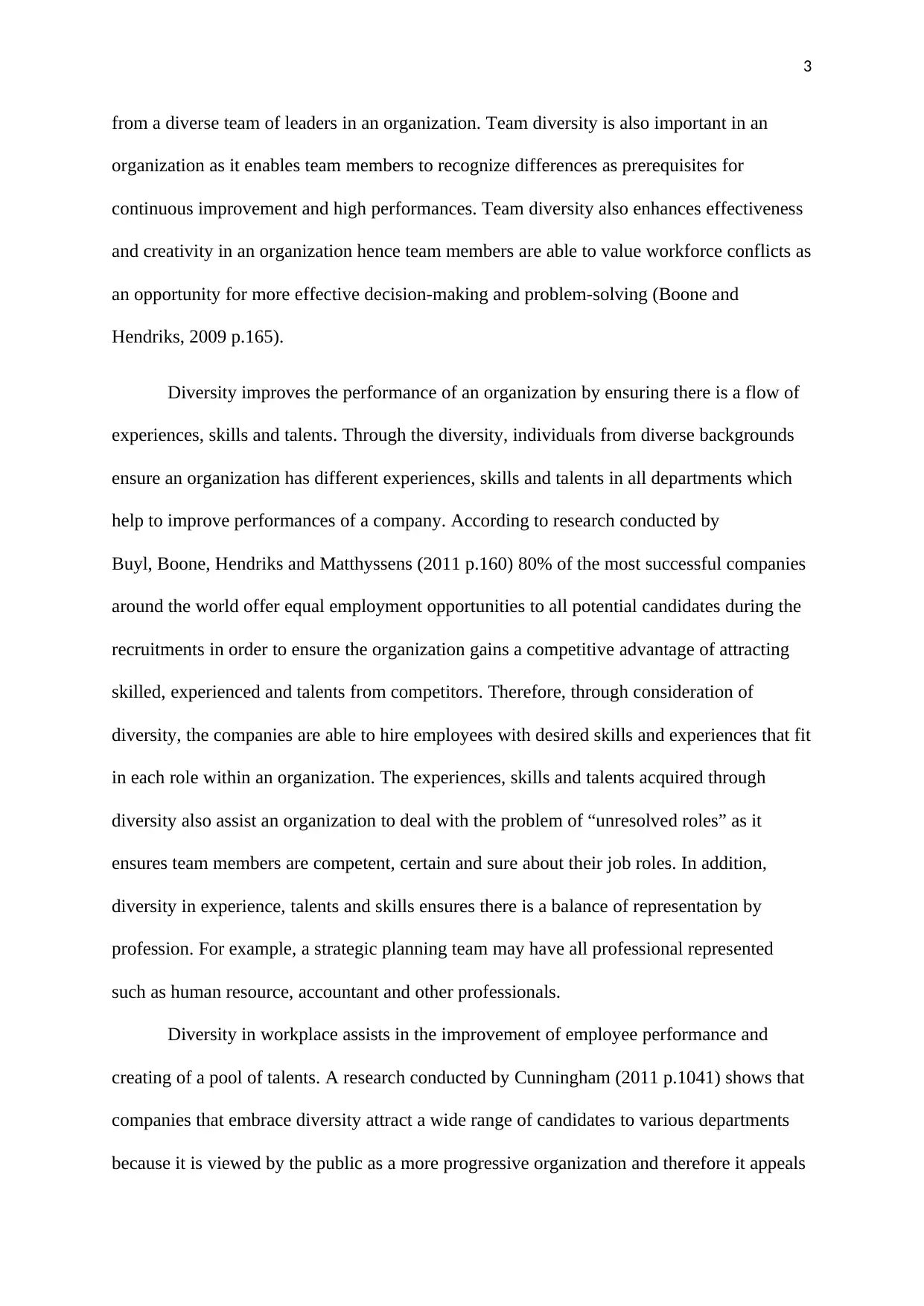
3
from a diverse team of leaders in an organization. Team diversity is also important in an
organization as it enables team members to recognize differences as prerequisites for
continuous improvement and high performances. Team diversity also enhances effectiveness
and creativity in an organization hence team members are able to value workforce conflicts as
an opportunity for more effective decision-making and problem-solving (Boone and
Hendriks, 2009 p.165).
Diversity improves the performance of an organization by ensuring there is a flow of
experiences, skills and talents. Through the diversity, individuals from diverse backgrounds
ensure an organization has different experiences, skills and talents in all departments which
help to improve performances of a company. According to research conducted by
Buyl, Boone, Hendriks and Matthyssens (2011 p.160) 80% of the most successful companies
around the world offer equal employment opportunities to all potential candidates during the
recruitments in order to ensure the organization gains a competitive advantage of attracting
skilled, experienced and talents from competitors. Therefore, through consideration of
diversity, the companies are able to hire employees with desired skills and experiences that fit
in each role within an organization. The experiences, skills and talents acquired through
diversity also assist an organization to deal with the problem of “unresolved roles” as it
ensures team members are competent, certain and sure about their job roles. In addition,
diversity in experience, talents and skills ensures there is a balance of representation by
profession. For example, a strategic planning team may have all professional represented
such as human resource, accountant and other professionals.
Diversity in workplace assists in the improvement of employee performance and
creating of a pool of talents. A research conducted by Cunningham (2011 p.1041) shows that
companies that embrace diversity attract a wide range of candidates to various departments
because it is viewed by the public as a more progressive organization and therefore it appeals
from a diverse team of leaders in an organization. Team diversity is also important in an
organization as it enables team members to recognize differences as prerequisites for
continuous improvement and high performances. Team diversity also enhances effectiveness
and creativity in an organization hence team members are able to value workforce conflicts as
an opportunity for more effective decision-making and problem-solving (Boone and
Hendriks, 2009 p.165).
Diversity improves the performance of an organization by ensuring there is a flow of
experiences, skills and talents. Through the diversity, individuals from diverse backgrounds
ensure an organization has different experiences, skills and talents in all departments which
help to improve performances of a company. According to research conducted by
Buyl, Boone, Hendriks and Matthyssens (2011 p.160) 80% of the most successful companies
around the world offer equal employment opportunities to all potential candidates during the
recruitments in order to ensure the organization gains a competitive advantage of attracting
skilled, experienced and talents from competitors. Therefore, through consideration of
diversity, the companies are able to hire employees with desired skills and experiences that fit
in each role within an organization. The experiences, skills and talents acquired through
diversity also assist an organization to deal with the problem of “unresolved roles” as it
ensures team members are competent, certain and sure about their job roles. In addition,
diversity in experience, talents and skills ensures there is a balance of representation by
profession. For example, a strategic planning team may have all professional represented
such as human resource, accountant and other professionals.
Diversity in workplace assists in the improvement of employee performance and
creating of a pool of talents. A research conducted by Cunningham (2011 p.1041) shows that
companies that embrace diversity attract a wide range of candidates to various departments
because it is viewed by the public as a more progressive organization and therefore it appeals
⊘ This is a preview!⊘
Do you want full access?
Subscribe today to unlock all pages.

Trusted by 1+ million students worldwide
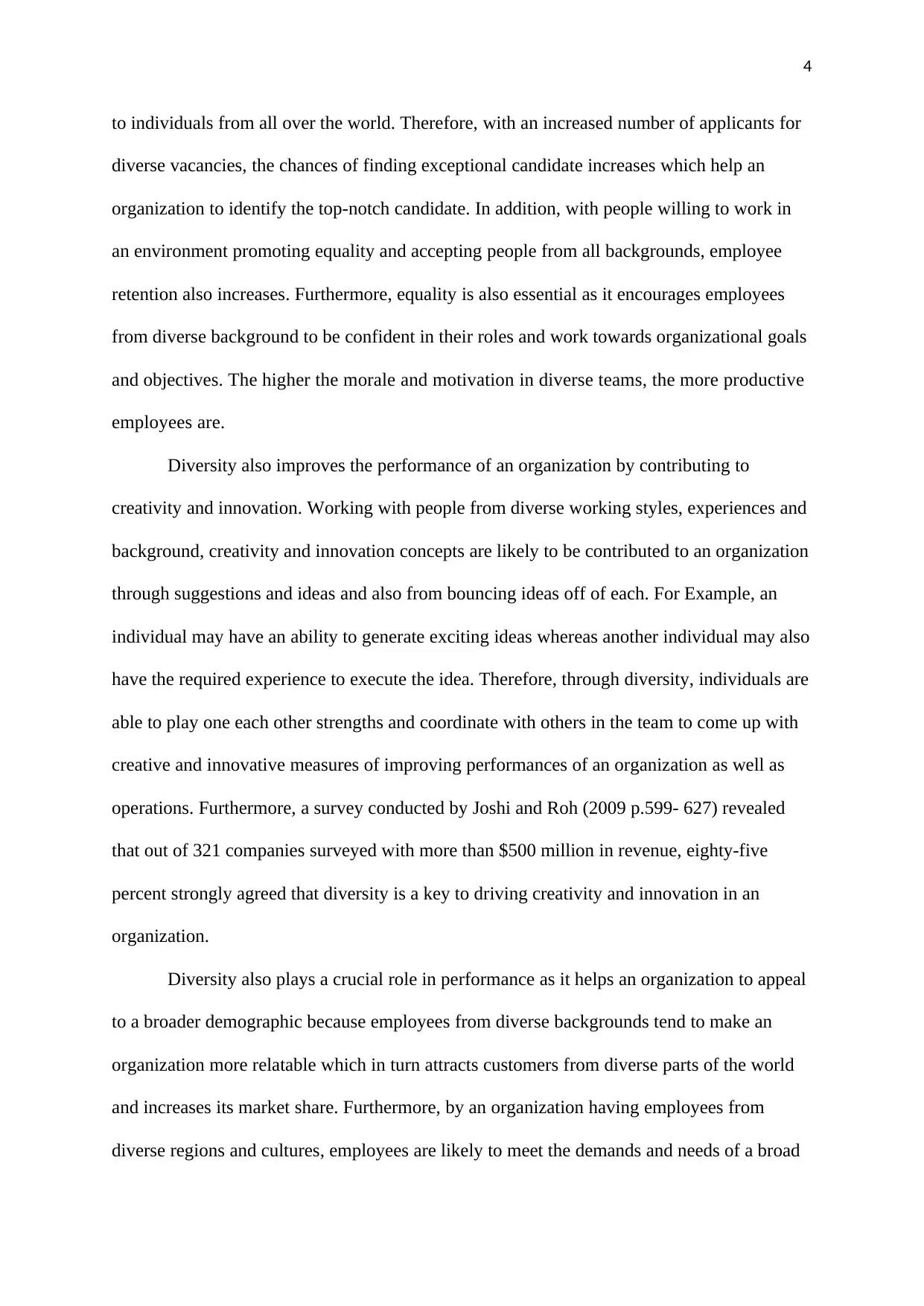
4
to individuals from all over the world. Therefore, with an increased number of applicants for
diverse vacancies, the chances of finding exceptional candidate increases which help an
organization to identify the top-notch candidate. In addition, with people willing to work in
an environment promoting equality and accepting people from all backgrounds, employee
retention also increases. Furthermore, equality is also essential as it encourages employees
from diverse background to be confident in their roles and work towards organizational goals
and objectives. The higher the morale and motivation in diverse teams, the more productive
employees are.
Diversity also improves the performance of an organization by contributing to
creativity and innovation. Working with people from diverse working styles, experiences and
background, creativity and innovation concepts are likely to be contributed to an organization
through suggestions and ideas and also from bouncing ideas off of each. For Example, an
individual may have an ability to generate exciting ideas whereas another individual may also
have the required experience to execute the idea. Therefore, through diversity, individuals are
able to play one each other strengths and coordinate with others in the team to come up with
creative and innovative measures of improving performances of an organization as well as
operations. Furthermore, a survey conducted by Joshi and Roh (2009 p.599- 627) revealed
that out of 321 companies surveyed with more than $500 million in revenue, eighty-five
percent strongly agreed that diversity is a key to driving creativity and innovation in an
organization.
Diversity also plays a crucial role in performance as it helps an organization to appeal
to a broader demographic because employees from diverse backgrounds tend to make an
organization more relatable which in turn attracts customers from diverse parts of the world
and increases its market share. Furthermore, by an organization having employees from
diverse regions and cultures, employees are likely to meet the demands and needs of a broad
to individuals from all over the world. Therefore, with an increased number of applicants for
diverse vacancies, the chances of finding exceptional candidate increases which help an
organization to identify the top-notch candidate. In addition, with people willing to work in
an environment promoting equality and accepting people from all backgrounds, employee
retention also increases. Furthermore, equality is also essential as it encourages employees
from diverse background to be confident in their roles and work towards organizational goals
and objectives. The higher the morale and motivation in diverse teams, the more productive
employees are.
Diversity also improves the performance of an organization by contributing to
creativity and innovation. Working with people from diverse working styles, experiences and
background, creativity and innovation concepts are likely to be contributed to an organization
through suggestions and ideas and also from bouncing ideas off of each. For Example, an
individual may have an ability to generate exciting ideas whereas another individual may also
have the required experience to execute the idea. Therefore, through diversity, individuals are
able to play one each other strengths and coordinate with others in the team to come up with
creative and innovative measures of improving performances of an organization as well as
operations. Furthermore, a survey conducted by Joshi and Roh (2009 p.599- 627) revealed
that out of 321 companies surveyed with more than $500 million in revenue, eighty-five
percent strongly agreed that diversity is a key to driving creativity and innovation in an
organization.
Diversity also plays a crucial role in performance as it helps an organization to appeal
to a broader demographic because employees from diverse backgrounds tend to make an
organization more relatable which in turn attracts customers from diverse parts of the world
and increases its market share. Furthermore, by an organization having employees from
diverse regions and cultures, employees are likely to meet the demands and needs of a broad
Paraphrase This Document
Need a fresh take? Get an instant paraphrase of this document with our AI Paraphraser
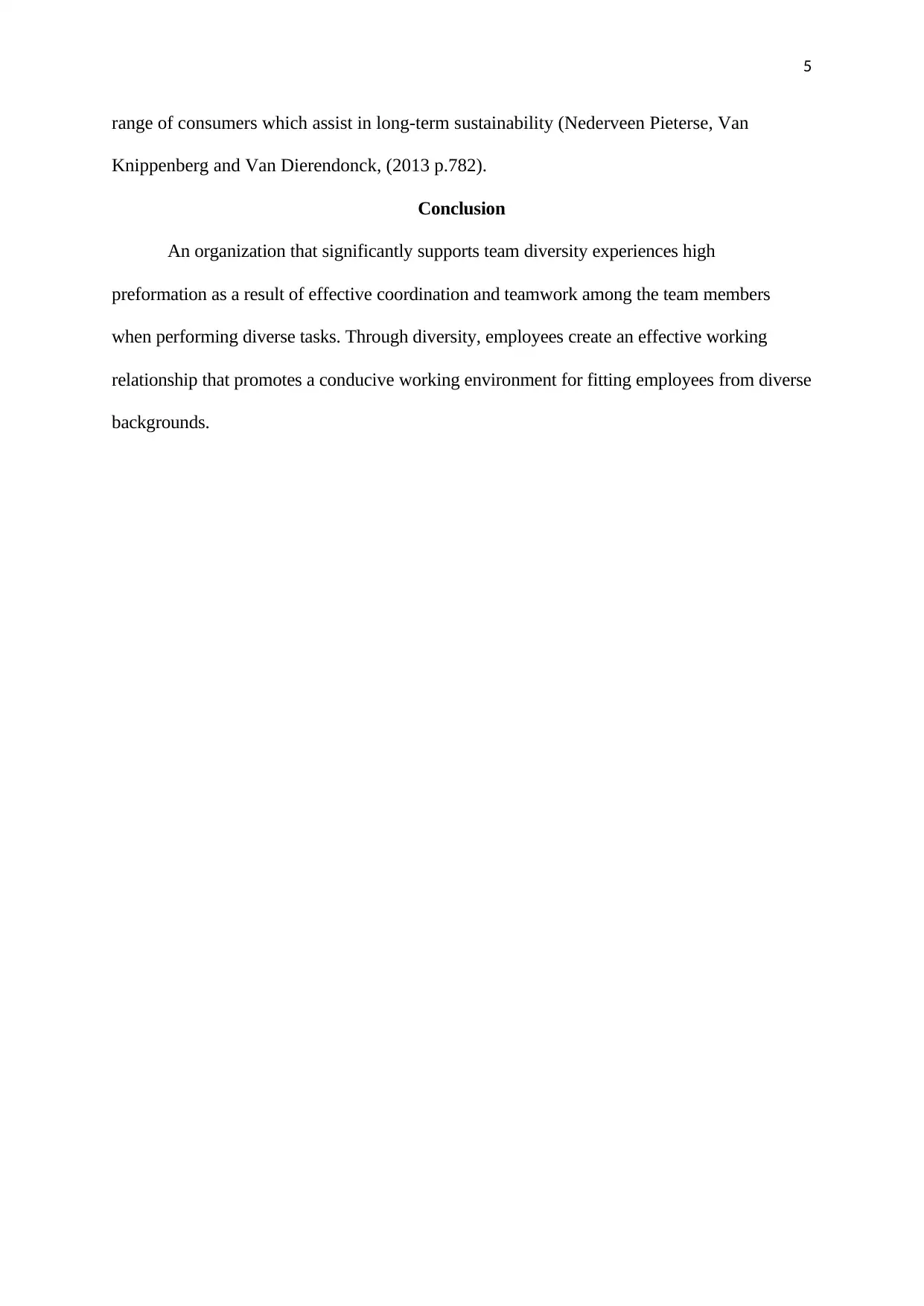
5
range of consumers which assist in long-term sustainability (Nederveen Pieterse, Van
Knippenberg and Van Dierendonck, (2013 p.782).
Conclusion
An organization that significantly supports team diversity experiences high
preformation as a result of effective coordination and teamwork among the team members
when performing diverse tasks. Through diversity, employees create an effective working
relationship that promotes a conducive working environment for fitting employees from diverse
backgrounds.
range of consumers which assist in long-term sustainability (Nederveen Pieterse, Van
Knippenberg and Van Dierendonck, (2013 p.782).
Conclusion
An organization that significantly supports team diversity experiences high
preformation as a result of effective coordination and teamwork among the team members
when performing diverse tasks. Through diversity, employees create an effective working
relationship that promotes a conducive working environment for fitting employees from diverse
backgrounds.
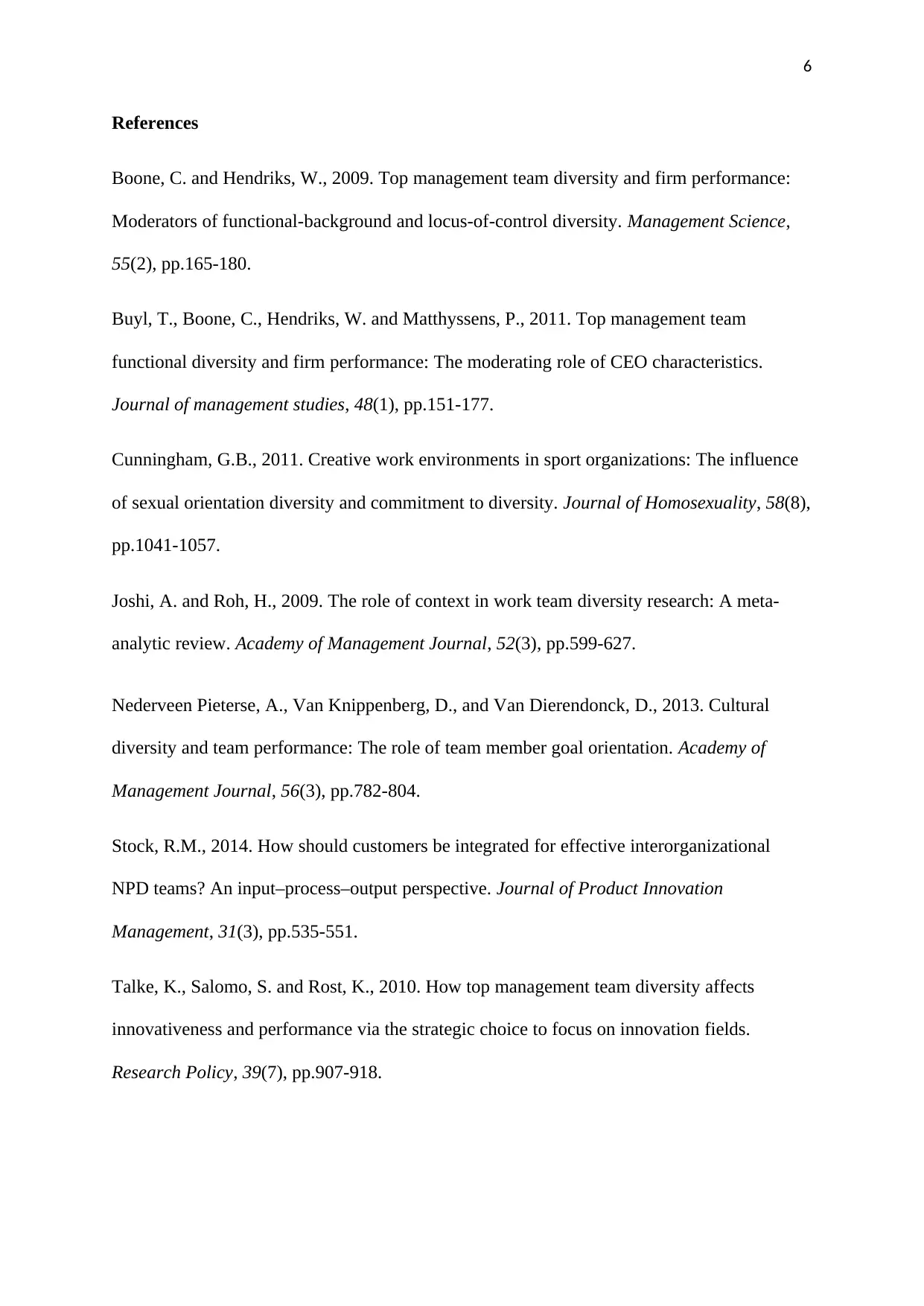
6
References
Boone, C. and Hendriks, W., 2009. Top management team diversity and firm performance:
Moderators of functional-background and locus-of-control diversity. Management Science,
55(2), pp.165-180.
Buyl, T., Boone, C., Hendriks, W. and Matthyssens, P., 2011. Top management team
functional diversity and firm performance: The moderating role of CEO characteristics.
Journal of management studies, 48(1), pp.151-177.
Cunningham, G.B., 2011. Creative work environments in sport organizations: The influence
of sexual orientation diversity and commitment to diversity. Journal of Homosexuality, 58(8),
pp.1041-1057.
Joshi, A. and Roh, H., 2009. The role of context in work team diversity research: A meta-
analytic review. Academy of Management Journal, 52(3), pp.599-627.
Nederveen Pieterse, A., Van Knippenberg, D., and Van Dierendonck, D., 2013. Cultural
diversity and team performance: The role of team member goal orientation. Academy of
Management Journal, 56(3), pp.782-804.
Stock, R.M., 2014. How should customers be integrated for effective interorganizational
NPD teams? An input–process–output perspective. Journal of Product Innovation
Management, 31(3), pp.535-551.
Talke, K., Salomo, S. and Rost, K., 2010. How top management team diversity affects
innovativeness and performance via the strategic choice to focus on innovation fields.
Research Policy, 39(7), pp.907-918.
References
Boone, C. and Hendriks, W., 2009. Top management team diversity and firm performance:
Moderators of functional-background and locus-of-control diversity. Management Science,
55(2), pp.165-180.
Buyl, T., Boone, C., Hendriks, W. and Matthyssens, P., 2011. Top management team
functional diversity and firm performance: The moderating role of CEO characteristics.
Journal of management studies, 48(1), pp.151-177.
Cunningham, G.B., 2011. Creative work environments in sport organizations: The influence
of sexual orientation diversity and commitment to diversity. Journal of Homosexuality, 58(8),
pp.1041-1057.
Joshi, A. and Roh, H., 2009. The role of context in work team diversity research: A meta-
analytic review. Academy of Management Journal, 52(3), pp.599-627.
Nederveen Pieterse, A., Van Knippenberg, D., and Van Dierendonck, D., 2013. Cultural
diversity and team performance: The role of team member goal orientation. Academy of
Management Journal, 56(3), pp.782-804.
Stock, R.M., 2014. How should customers be integrated for effective interorganizational
NPD teams? An input–process–output perspective. Journal of Product Innovation
Management, 31(3), pp.535-551.
Talke, K., Salomo, S. and Rost, K., 2010. How top management team diversity affects
innovativeness and performance via the strategic choice to focus on innovation fields.
Research Policy, 39(7), pp.907-918.
⊘ This is a preview!⊘
Do you want full access?
Subscribe today to unlock all pages.

Trusted by 1+ million students worldwide
1 out of 6
Related Documents
Your All-in-One AI-Powered Toolkit for Academic Success.
+13062052269
info@desklib.com
Available 24*7 on WhatsApp / Email
![[object Object]](/_next/static/media/star-bottom.7253800d.svg)
Unlock your academic potential
Copyright © 2020–2025 A2Z Services. All Rights Reserved. Developed and managed by ZUCOL.





